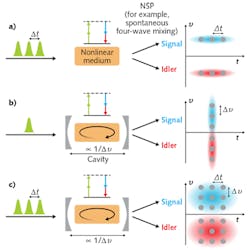10-nm-thick photodetector with gold electrodes senses optical fiber’s evanescent field
Researchers at Rice University (Houston, TX) have developed a method to make atom-flat sensors, including photosensors, that seamlessly integrate with devices to report on what they perceive. Electronically active 2D materials have been the subject of much research since the introduction of graphene in 2004. Even though they are often touted for their strength, they’re difficult to transfer to where they’re needed without destroying them. The new research provides a way to keep the materials and their associated circuitry, including electrodes, intact as they are moved to curved or other smooth surfaces. The Rice team tested the concept by making a 10-nm-thick indium selenide (InSe) photodetector with gold electrodes and placing it onto the side of a stripped optical fiber. Because it was so close, the near-field sensor coupled with the evanescent field of the fiber and accurately detected the flow of information inside. The benefit is that these sensors can now be embedded into such fibers so that they can monitor performance without adding weight or hindering the signal flow—for example, to sense damage at any point along a long telecommunications fiber.
Raw 2D materials are often moved with a layer of polymethyl methacrylate (PMMA) on top, and the Rice researchers make use of that technique. But they needed a robust bottom layer that would not only keep the circuit intact during the move, but could also be removed before attaching the device to its target. (The PMMA is also removed when the circuit reaches its destination.) The ideal solution was polydimethylglutarimide (PMGI), which can be used as a device fabrication platform and easily etched away before transfer to the target. PMGI appears to work for any 2D material, as the researchers experimented successfully with molybdenum diselenide and other materials as well. The researchers have only developed passive sensors so far, but they believe their technique will make active sensors or devices possible for telecommunication, biosensing, plasmonics, and other applications. Reference: Z. Jin et al., ACS Nano (2018); https://doi.org/10.1021/acsnano.8b07159.
About the Author
John Wallace
Senior Technical Editor (1998-2022)
John Wallace was with Laser Focus World for nearly 25 years, retiring in late June 2022. He obtained a bachelor's degree in mechanical engineering and physics at Rutgers University and a master's in optical engineering at the University of Rochester. Before becoming an editor, John worked as an engineer at RCA, Exxon, Eastman Kodak, and GCA Corporation.

